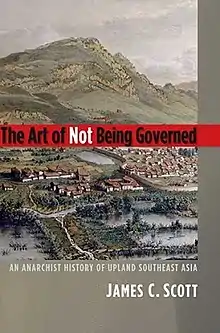The Art of Not Being Governed
The Art of Not Being Governed: An Anarchist History of Upland Southeast Asia is a book-length anthropological and historical study of the Zomia highlands of Southeast Asia written by James C. Scott published in 2009.[1][2] Zomia, as defined by Scott, includes all the lands at elevations above 300 meters stretching from the Central Highlands of Vietnam to Northeastern India. That encompasses parts of Vietnam, Cambodia, Laos, Thailand, and Myanmar, as well as four provinces of China. Zomia's 100 million residents are minority peoples "of truly bewildering ethnic and linguistic variety", he writes. Among them are the Akha, Hmong, Karen, Lahu, Mien, and Wa peoples.[3]
 First edition | |
| Author | James C. Scott |
|---|---|
| Publisher | Yale University Press |
Publication date | 30 September 2009 |
| Media type | Hardcover |
| ISBN | 9780300152289 Also available in Paper (ISBN 9780300169171) and eBook |
| Part of a series on |
| Political and legal anthropology |
|---|
| Social and cultural anthropology |
Argument
For two thousand years, the disparate groups that now reside in Zomia (a mountainous region the size of Europe—2.5 million km2—that consists of portions of seven Asian countries) have fled the projects—slavery, conscription, taxes, corvée, epidemics, and warfare—of the nation state societies that surround them.[2][4] This book, essentially an “anarchist history", is the first examination of the huge literature on nation-building whose author evaluates why people would deliberately choose to remain stateless.
Scott's main argument is that these people are "barbaric by design": their social organization, geographical location, subsistence practices and culture have been maintained to discourage states from curtailing their freedoms.[5] States want to integrate Zomia peoples and territory to increase their landholdings, resources, and people subject to taxation—in other words, to raise revenue.[1] Scott argues that these many minority groups are "...using their culture, farming practices, egalitarian political structures, prophet-led rebellions, and even their lack of writing systems to put distance between themselves and the states that wished to engulf them."[3] Tribes today do not live outside history according to Scott, but have "as much history as they require" and deliberately practice "state avoidance".[6]
Scott admits to making "bold claims" in his book, but credits many other scholars, including the French anthropologist Pierre Clastres and the American historian Owen Lattimore, as influences.[3]
References
- Scott, James C (30 September 2009). The Art of Not Being Governed: An Anarchist History of Upland Southeast Asia (Hardcover). New Haven: Yale University Press. ISBN 9780300152289. Retrieved 20 April 2020.
- Sethness, Javier (3 July 2011). "Refugees' Descendants in Southeast Asia Prove Stateless Society Is Possible" (Review). Truthout. Retrieved 20 April 2020.
- Hammond, Ruth (4 September 2011). "The Battle Over Zomia". The Chronicle of Higher Education. Retrieved 20 April 2020.
- Bennett, Drake (6 December 2009). "The mystery of Zomia". Boston.com. Retrieved 20 April 2020.
- Ernst, Gabriel (21 October 2019). "'We try to not be Thai': the everyday resistance of ethnic minorities". New Mandala. Retrieved 20 April 2020.
- Kaplan, Robert D (12 April 2011). "Foreign Policy: Why It's Hard For Strongmen To Leave". NPR. Retrieved 20 April 2020.
External links
Reviews
- The Art of Not Being Governed: An Anarchist History of Upland Southeast Asia review by Foreign Affairs
- History of people without history review by The Hindu
- The Art of Not Being Governed: An Anarchist History of Upland Southeast Asia review by The Independent Institute[1]
- Life on the Edge review by Reason
- The Art of Not Being Governed: An Anarchist History of Upland Southeast Asia review by Reviews in History
- The Art of Not Being Governed: An Anarchist History of Upland Southeast Asia review in Journal of Folklore Research Reviews (subscription required)
- Thompson, Thomas J. (Summer 2011). "The Art of Not Being Governed" (Review). The Independent Review. 16 (1). Retrieved 20 April 2020.